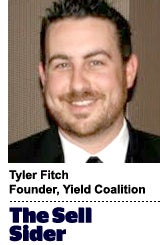 “The Sell-Sider” is a column written by the sell side of the digital media community.
“The Sell-Sider” is a column written by the sell side of the digital media community.
Today’s column is written by Tyler Fitch, founder of Yield Coalition.
When I first started managing remnant yield for large websites, everything seemed to be cut and dry. You had your ad server, maybe an exchange, and you worked directly with each ad network, which had direct agency relationships.
Now, everything is muddled together.
Traditional ad networks claim they are supply-side platforms (SSPs), traditional SSPs have built themselves into big ad exchanges and exchanges sell to companies taking ad-network margins before it gets to the publisher.
How is this fixing advertising? Most networks/exchanges/SSPs are an entangled mess of middlemen that are arbitraging demand they didn’t even sell in the first place.
Publishers need to ask themselves: Do these third parties actually provide value? Could you source these deals higher up the chain? Let’s take a closer look.
SSPs
They have been evolving over the past few years, but at one point, SSPs realized they needed to differentiate themselves from each other – and increase their margins – so they moved quickly to bring on real-time bidding (RTB). These huge marketing machines soon let everyone know that you weren’t cool unless you used this thing called RTB.
But last time I checked, a platform with a bunch of demand-side platforms (DSPs) bidding via RTB was called an “ad exchange.” The SSPs spent millions to build a huge RTB infrastructure only to make a product that was already included in most ad servers. The SSPs later built new features, but those are only available on their platform and not through the ad server.
Google’s acquisition and integration of SSP Admeld into DoubleClick Ad Exchange was ideal for publishers because it took the tools that these SSPs built — such as price flooring and private exchanges — and integrated them seamlessly into DFP. Less fragmentation with more publisher flexibility will always win.
Exchanges
This is a tough one for me because I really love the idea of what an exchange does. The problem with most exchanges is that they are agnostic platforms. They cater to the reseller because of the fact that they make more money that way. The reseller is selling to the reseller and so on, with the exchange taking a cut of every impression. This dilutes CPMs and causes transparency problems. I know it’s a pipe dream as this would cause huge revenue hits to the exchange business, but ad exchanges should be selling publisher-direct only, not to third-party networks.
Ad Networks
First of all, an ad network is not an SSP, no matter what it may say. The ad network is an ad tag that sits in the publisher’s ad server and competes with everyone else. If you call yourself an “SSP,” it just means you have more middlemen taking a cut out of your already large margins. The publisher is probably already working with that company through their main exchange.
Another type of ad network is the “exchange reseller” – ad networks that pay at higher CPMs but only fill inventory they “match” up with. This is a so-called “network” that takes a third-party exchange, puts a floor price on it and gives it to another publisher at a lower price (this is allowed by the exchanges as mentioned in the previous paragraph). If the network actually had direct deals, it would be buying it programmatically through an exchange and not directly through an ad tag. Once again, just another middleman with a hand in the publisher’s pocket.
Publishers only need networks with direct relationships. I don’t care if it’s performance or brand. As a publisher, I just want the highest payout with the least amount of middlemen. I can take care of the optimization piece from there.
Consequently, publishers need one platform. One platform should house your direct sales, programmatic, DMP, SSP and everything else in between. Reduce the middleman, reduce the fragmentation and keep more revenue in your pocket instead of somebody else’s. When working with third parties, realize the value that each company brings to the table. Do they extract value from your users or are they just taking margin from demand already available to you?
Work smart and take each company for what they are – not what they say they are.
Follow Tyler Fitch (@tylerwfitch), Yield Coalition (@yieldcoalition) and AdExchanger (@adexchanger) on Twitter.












